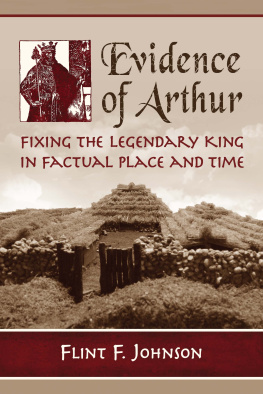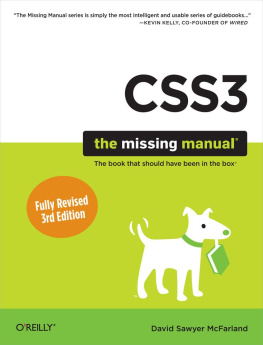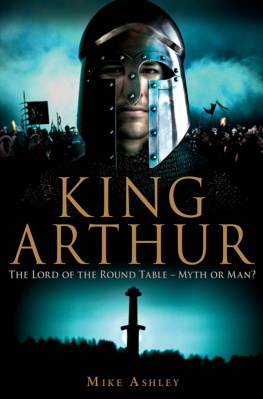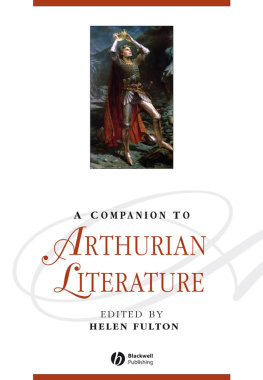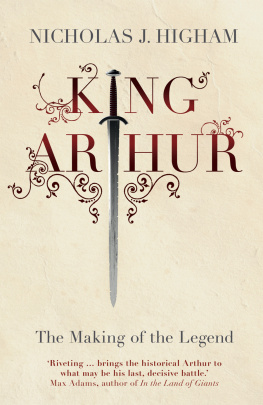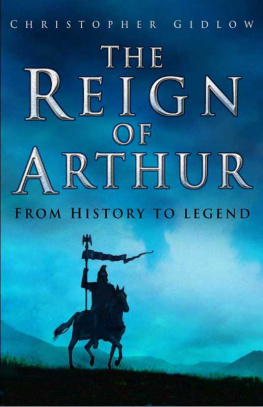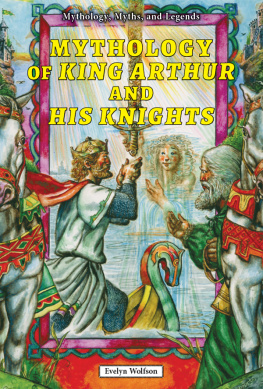Also by FLINT F. JOHNSON
Hengest, Gwrtheyrn and the Chronology of Post-Roman Britain (2014)
Origins of Arthurian Romances: Early Sources for the Legends of Tristan, the Grail and the Abduction of the Queen (2012)
Evidence of Arthur
Fixing the Legendary King in Factual Place and Time
FLINT F. JOHNSON

McFarland & Company, Inc., Publishers
Jefferson, North Carolina
LIBRARY OF CONGRESS CATALOGUING DATA ARE AVAILABLE
BRITISH LIBRARY CATALOGUING DATA ARE AVAILABLE
e-ISBN: 978-1-4766-0628-6
2014 Flint F. Johnson. All rights reserved
No part of this book may be reproduced or transmitted in any form or by any means, electronic or mechanical, including photocopying or recording, or by any information storage and retrieval system, without permission in writing from the publisher.
On the cover: model of a hypothetical construct of Arthurs home by Kenna Bjerstedt (photograph by Emily Adler); inset King Arthur of Britain, by Howard Pyle from The Story of King Arthur and His Knights, 1903 (Wikipedia Commons)
McFarland & Company, Inc., Publishers
Box 611, Jefferson, North Carolina 28640
www.mcfarlandpub.com
Source Abbreviations
AA Archaeologica Aeliana
Antiq Antiquity
ASE Anglo-Saxon England
Brit Britannia
BBCS Bulletin of the Board of Celtic Studies
CMCS Cambridge/Cambrian Medieval Celtic Studies
EHR English History Review
EC tude Celtique
MLN Modern Language Notes
MP Modern Philology
NMS Nottingham Mediaeval Studies
PBA Proceedings of the British Academy
PMLA Publications of the Modern Language Association of America
S Speculum
SC Studia Celtica
THSC Transactions of the Honourable Society of the Cymmrodorion
WHR Welsh History Review
ZDP Zeitschrift Deutsche Philosophie
Preface and Acknowledgments
While writing a thesis on several romances associated with Arthur, I came across an article written by Dr. Oliver Padel, The Nature of Arthur. Even at that early date in my academic career, I was aware that the articles case of Arthurs historicity was not a balanced one, and thus I immediately composed a rejoinder that sought to rectify the inadequacy. I retained that paper in my files, but never published it. Throughout graduate school and since then, the paper has been improved upon and expanded as more ideas and better approaches have occurred to me. The product of all those ruminations is laid out below.
The present monograph is a sequel to my recent book, Origins of Arthurian Romance: Early Sources for the Legends of Tristan, the Grail, and the Abduction of the Queen. It employs the methodology developed in that previous work as an approach to a study of Arthur, and with it the exacting examination of all pertinent sources.
The current book is divided into three parts. Each has been designed so that, in part or as a whole, they are dependent on those preceding it. The opening group of chapters has been devoted to multiple approaches to the issue of Arthurs historicity. There follows a detailed examination of his possible area of activity and the years he flourished.
All three parts will make use of the same pool of resources. In moving forward from Origins of Arthurian Romance, that pool will include purely literary as well as pseudo-historical and historical materials. With their strengths and weaknesses known as determined by scholarship on each individual piece, each work will be employed only where its usefulness is credible. No source is used exclusively.
* * *
As this volume was formulated largely on the research and knowledge I collected during the construction of my Ph.D., I find that I must thank many of the same people. I greatly appreciate Mr. Warren and Mr. Schleh for their confidence in me and the support they have given me for many years. I wish to thank Dr. Wood and Professor Caie for their persistence and patience in helping me to develop my writing style. They have both proven generous friends long after I was officially their student. I would also like to note here the patience and persistence of my sister, Kenna. It is her offering which appears on the front cover, and it was only through many patient hours of discourse that I was finally able to relate what I was after in this hypothetical recreation of Arthurs home, Camelot. Only she knows how many hours of tedious work went into it. Thank you.
I have benefited greatly from several conversations with Dr. Thomas Clancy and Dr. Rachel Bromwich; they have guided me away from many pitfalls. I have often sought their advice pertaining to this volume. In the final stages of this book, I have enjoyed the insights and guidance of Professor Clyde Smith and the editorial patience of Michelle Klein. However, I take full responsibility for any misunderstanding or error in those dialogues. Many of the views that I have expressed here are not those of any other scholar. Most of all, I would like to express my gratitude again to my personal muse. Thank you, Marina. As abstract as your help has been, it has been essential to this and to me.
Introduction
In 825, King Hywel of Gwynedd died, and with him a dynasty that had included Maelgwn and Cadwallon came to an end. Hywel was replaced in the next year by his son-in-law Merfyn Frych, whose family was descended from Urien through the dynasty of Man. Merfyn was the first in his own Gwynedd dynasty, one that would last well into the Middle Ages. It is only natural that such an important change occurring within a powerful kingdom would have caused a great deal of internal unrest. That upheaval might easily have been taken advantage of by outside powers such as the Germanic kingdoms who had been pressuring the Welsh for centuries. It was not, however, and in this Merfyn was extremely fortunate. His accession took place during a period of disorder in Wessex. Their king, Cwulf, would die in 821, to be succeeded by Ceolwulf. The new ruler would continue the aggressive policies into Wales that had been characteristic of the dynasty, but he would be killed in a factional conflict in 823. Beornwulf would be the next leader of Wessex and would live only till 825. When Merfyn assumed the Gwynedd throne, Wessex was in the process of trying to find its fourth king in six years. It would be some time before the kingdom would be able to solidify itself once again.
Because of the respite, Merfyn would not only be able to stabilize his own dynasty, but he and those who followed him would initiate a change of policy. The kings of Gwynedd would, from this point on, actively engage in trying to organize the surviving British states into a united front against the English. This would be done through centuries of warfare, many marital alliances, and the recovery and transmission of northern British oral and possibly written literature from Strathclyde to Gwynedd. It is this last accomplishment that will be the focus for the remainder of this chapter.
Merfyn was the first to attempt any of this, and his accomplishments were the most far-reaching. Much of the material that was gathered at his instigation was forged into prose form as the Historia Brittonum. This book had an agenda with two specific goals. First, he used it to strengthen the hold his dynasty had on the kingdom of Gwynedd. To forward this objective, the author shows the common northern heroic tradition which Merfyns forefathers and Hywels predecessors had shared. The author located the origins of both dynasties in the north. He then set about focusing his narrative on prominent characters from both lineages, and the prominent ancestors of the house to which Gwynedd was closely allied with at the time, Powys.
Next page
